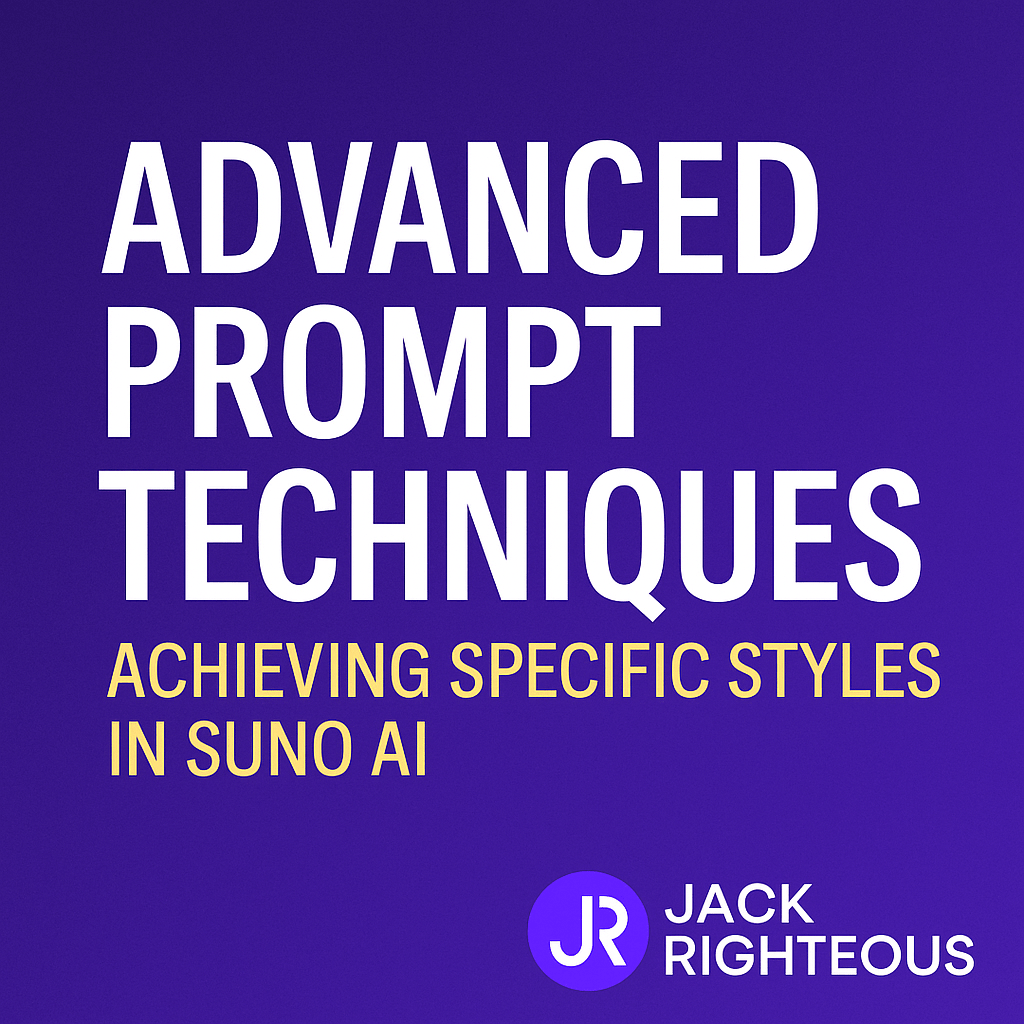
Advanced Prompt Techniques: Achieving Specific Styles in Suno AI
Gary Whittaker
Advanced Prompt Techniques: Achieving Specific Styles in Suno AI
Recommended for: 🎯 Individual Creators, 🎯 Mission-Driven Voices, 🎯 Product Marketers
Welcome to STAGE 1 of the Suno V4.5 Creator Workflow: mastering advanced prompt construction. Whether you're building music for a product, a message, or personal expression, well-built prompts help steer emotion, structure, and sonic output with professional accuracy.
Use this article alongside the full Prompt Style Guide (V4.5) and the GET JACKED Starter System to map out your tags, structure, and style foundation.
Section 1: Why Advanced Prompts Matter
- Refining Creativity: Go beyond generic outputs by shaping your sound precisely.
- Achieving Specific Outcomes: The more intentional your inputs, the more aligned your song will be with your vision.
- Expanding Control: Detailed prompts unlock the full potential of Suno’s instrumentation, mood, and structure control.
Section 2: Pro Techniques for Advanced Music Prompts
1. Use Prompt Modules Instead of Full Sentences
Break prompts into components so you can mix, test, and iterate easily:
- Prompt Format: [Mood] [Genre] with [Lead Instrument] and [Supporting Instrument], [Tempo], [Key], [FX/Atmosphere]
- Example: “Dark cinematic trap with ambient pads and distorted guitar, mid-tempo, D minor, eerie atmosphere”
2. Emotion Comes First
Place emotional intent at the front to guide genre and tone selection.
- Prompt Starter: “Hopeful [Genre] with...” or “Tense, cinematic...”
3. Be Specific, But Don’t Overload
Pick 3–5 meaningful descriptors. More can confuse the AI.
4. Tempo and Key Tags Can Anchor Output
Include if you want consistency in your sound bank.
- Example: “Slow tempo reggae in D minor, with warm harmonies”
5. Avoid Copyright Risk
Don’t name artists. Instead, describe their style.
- Instead of: “Like Kanye West”
- Use: “Minimalistic trap with soulful samples and spoken-style rap flow”
Section 3: Advanced Lyric Prompt Techniques
1. Use This Prompt Format for Lyrics
Theme: [Insert emotional, spiritual, or social concept] Structure: - Verse 1: [Set the stage] - Chorus: [Main hook or emotional high point] - Verse 2: [Resolution or shift] Key phrases: [Custom phrases that reinforce your message]
2. Sync Lyric Structure to Music Prompt
Make sure energy, tone, and phrasing match your selected musical elements. For example, a slow tempo track benefits from short, weighted lyrics with space for instrumental breathing.
3. Prompt for Tone or Persona
- Prompt Starter: “Uplifting lyrics written from the voice of a mentor, speaking to a lost generation...”
Section 4: Remix, Replace, Reuse
Use the “Prompt to Track” Iteration Loop
- Test multiple versions (e.g., 2–3 variations of same style with lyric shifts)
- Use Suno’s Replace or Extend tools to isolate and fix weak sections
- Label all exports clearly with version and purpose
Naming Tip: Use a format like: TrackTitle_Emotion_Style_V2.wav
Use Clip Testing to Stress Test Hooks
Generate short 15–30 sec versions of your core idea before making full tracks.
Section 5: Troubleshooting Tips
- Too Generic? → Add tone, tempo, and an instrument focus.
- Lyrics Misfire? → Clarify emotional intent and persona. See Starter System.
- Loops Don’t Clean? → Use “loop-friendly” tags or crop/fade manually in post.
Section 6: Go Further with Pro Tools
Unlock better results by combining this guide with:
- Suno Genre Prompt Guide (V4.5) – Full tag library + examples
- GET JACKED Starter System – Maps your brand, theme, and sound
- Join Suno Here (250 Free Credits)
Final Thoughts
You don’t need to be a producer to think like one. You just need the right system. Use these advanced techniques to shape your prompts, connect with your audience, and elevate your output.
Then head to GET JACKED and turn that sound into something that sells.
